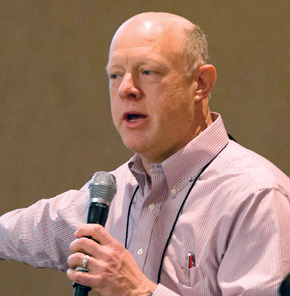In his general session presentation at the 2015 Dealership Minds Summit in Cincinnati in January, Birkey’s Farm Store President/CEO Mike Hedge also covered service productivity issues and the high cost of unapplied labor most farm equipment dealerships experience. And he encouraged dealers to start looking at service techs through a lens of inventory units.
“There is a high cost of unapplied labor in our dealerships. Not only do we miss out on labor sales, but also the parts sales that go with it.
“A number of different formulas calculating productivity; most will include taking the hours billed in the numerator divided by some number like the hours paid, hours worked, hours in the shop, etc. But I’d challenge all of us to start looking at our service techs like inventory.
“We don’t buy a piece of wholegoods or put parts on the shelf and then, at the end of the week, throw it away. But when we hire a service technician, we are buying 2000 hours of inventory in a year to sell. And when that service technician does not bill that those 40 hours inventory, it becomes a dead expense — it’s just like throwing parts off the shelf.
“By not having work scheduled in advance or by a lack of management in our service departments, how often do we just write off this time as obsolete? Dealers sometimes excuse this in a way that we wouldn’t with equipment or parts.
“Regardless of how you calculate service productivity, the focus needs to be on productivity in selling those hours available to sell.

“When we hire a service technician, we are buying 2000 hours of inventory in a year to sell. And when that service technician does not bill that those 40 hours inventory, it becomes a dead expense—it’s just like throwing parts off the shelf.”
Create Visibility & Watch Results
“One of the things that we’ve done that’s created the most visibility on service time is to let your unapplied be seen. If the tech is not billing on a repair order, it’s unapplied time. Unapplied is any time that cannot be applied to the servicing of equipment in our shops. It includes lot work, hauling, loitering around the office, sweeping the floors, etc. Training can be an acceptable reason for unapplied time.
“It shouldn’t be buried in your cost of sales. I’d encourage you to only charge cost of sales for the time actually punched into repair work on a piece of equipment. If a tech is not working on a piece of equipment and billing time, it is unapplied.
“Separating it out from cost of sales does two things. First, it makes the unapplied time much more visible and second, it allows us to better track gross margin and gross margin % by technician.
“We’ve made some real strides this past year when we started putting out a report each morning to service managers and store managers that showed the prior day’s and month-to-date unapplied time — by technician.
“In the past, unapplied time was seen only at the end of the month when the general job ticket was closed. The problem was that that the service managers and store managers could be “surprised” by just how much the unapplied time was. Worse, the feedback was not timely enough to effectively deal with it.
“Now, managers see it every day and can be out talking to their techs when they see someone who had 2 hours that wasn’t punched in the day before.
“This daily update engages the store manager in the discussion along with the service manager, and the service managers engage with their technicians on a daily basis to address lost time.”

Mike Hedge will be speaking at the 2023 Dealership Minds Summit to share How to communicate basic financial terms to your staff, what they measure and how they fit together
Click the button below to register!
Related Content:
-
How Leverage & Inventory Turnover Keep the Balance Sheet in Order
This executive shares his approach to teaching employees throughout the dealership the importance of leverage and turnover, the guard rails for keeping the balance sheet — and dealership — on track.






